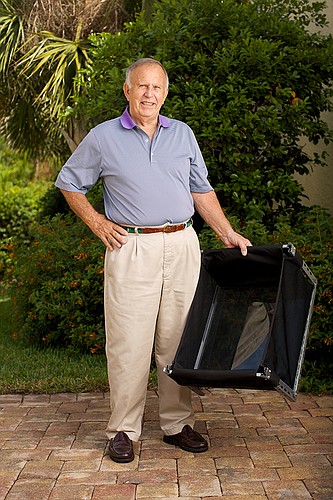- November 24, 2024
-
-
Loading

Loading

Donald Avery knows all about boxes. After all, the Bonita Springs-based entrepreneur was on the team that designed the unique cylindrical Pringles potato chips container.
Avery started his career in what's called primary packaging, the cans and jars you find on the supermarket shelves. But in the early 1990s, he was designing packaging for the shipping industry.
What Avery saw in his years in the shipping business was extensive waste, especially cardboard boxes that can only be used once. What's more, cardboard boxes absorb moisture, spoiling the contents and disintegrating easily. “There has to be a better material,” Avery remembers thinking.
For example, companies that ship perishable goods such as vegetables in stacks of corrugated-cardboard containers may lose as much as a quarter of their goods because the cardboard rips, gets crushed or disintegrates. What's more, the paper packaging can promote bacteria growth if there's moisture.
Using Nucor galvanized steel made from 94% recycled scrap, Avery designed a metal skeleton for his box he calls the Reusable Transport Package. A user can then customize the vessels or bins inside the frame. They're arranged on a shelving system that protects the product inside from being crushed. The vessel or bin can be made from almost any material, from fabric to plastic.
Because the super-strong steel skeleton can be easily broken down, the packaging can be reused dozens of times. Shipping companies can collect the metal frame and bins and reassemble them easily for reuse. This is important because European countries and Canada now require shippers to dispose of their customers' packaging materials in regulations the industry terms “extended producer responsibility.”
The cost of Avery's box is $15 to $20 a unit (it comes in three sizes), but the fact that shippers can reuse it makes it less expensive in the long run. For example, the Avery box pays for itself after 10 uses. If a shipper uses the Avery box 50 times, that's 20% of the cost of spending on cardboard.
In 2006, Avery filed for a patent on his box, which he obtained in 2009 with the help of a computer-assisted design technician. Intellectual property attorney Peter Gilster of the Greensfelder Law Firm in Missouri helped him navigate the patent process and Pro-Pack Testing Laboratory in Belleville, Ill., tested it and certified it to conform to shipping-industry standards. Avery estimates he's spent several hundreds of thousands of dollars on the project so far. “I can't give up now,” he laughs.
In 2008, Avery formed Avery Packaging in Bonita Springs, and he's been refining the system for sale. The challenge has been to find the first customer. “Nobody wants to be the first on a new package,” Avery says. “It's hard to get in to talk to anybody. They don't have time.”
One advantage Avery has is that cardboard box manufacturers don't offer this kind of technology. “I don't think they know I exist,” he says with a smile.
Avery moved to Bonita Springs from Missouri a year ago. He says Southwest Florida is an ideal location for his business because of the agriculture industry. “It's one of the biggest grower-shipper areas of the country,” he says.
Despite the marketing challenges, Avery says he's working with an undisclosed packaging company that will likely be his first customer. Avery is talking to a manufacturer in North Florida about making the boxes, which would take about three months from tooling to production. “I'm just trying to get somebody started here,” he says.
Follow Jean Gruss on Twitter @JeanGruss